The Leatherman:
Connecticut's Wandering Hobo
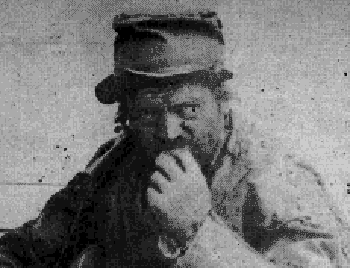
Article and photos by Jeff Belanger
Since 1862, many have heard the tale of a wandering
vagrant who traveled in an endless 365-mile circle between the
Connecticut and Hudson rivers. The strange man only spoke with grunts
or gestures and dressed in crudely stitched leather from his hat to
his shoes. The suit was made of heavy pieces of raw leather estimated
to have weighed more than sixty pounds in total. It was a coat of
armor the vagrant depended on to protect him from the sometimes harsh
New England elements. "Leatherman," as he was dubbed by
those who encountered him, would only sleep outside year-round -- and
mostly in caves around Connecticut and New York.
Some claim old Leatherman is still making his endless journey today,
through the woods, mountains, and river valleys of Connecticut and New
York state.
A wandering vagrant is nothing surprising. American folklore has more
of them than could fill a thousand railroad boxcars. What makes the
Leatherman unique is his incredible precision in daily routine. He
would arrive in the same location every 34 days.
Many different families took it upon themselves to feed the
Leatherman. Since he arrived at precisely 34-day intervals, and at the
same time of day, some would have a meal prepared for his arrival. He
would grunt or make appreciative gestures and then quickly move along
to keep his tight schedule.
The Leatherman was first seen in Connecticut in 1862, and all who
encountered him wanted to know who he was and where he came from.
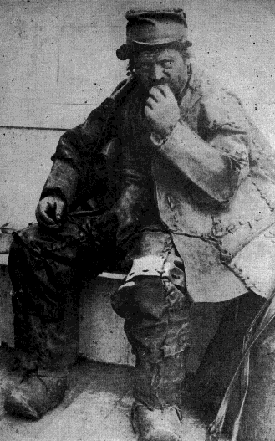
Jules Bourglay - The Leatherman
from The Lure of Litchfield Hills magazine
December, 1952
Lyons, France
The Leatherman's tale begins in Lyons, France in the 1820s. A young
couple named Bourglay had a son, Jules. The Bourglay family's
occupation was woodcutting, and the income from their labors afforded
them a certain level of distinction. They were of a lower middle class
during a time when your social station was all-important. Your
family's wealth would determine your entire future: what kind of job
you would have, who you would marry, and if you could go to school.
Young Jules Bourglay met and fell in love with Miss Margaret Laron,
the daughter of a somewhat wealthy leather merchant. Jules approached
Margaret's father to ask for his daughter's hand in marriage.
The marriage request was met with an objection, primarily due to the
differences in class between the Bourglay and Laron families. After
much pleading, and further meetings, it was decided that Jules would
be given the opportunity to work in the Laron family leather business,
and if he could acquire the trade and be successful, he would be
granted permission to marry Margaret.
Jules Bourglay worked hard at the leather business and was quickly
given more responsibilities, including the purchase of more leather on
the open market. One day in 1855, Jules made a large leather purchase.
Then, almost overnight, the price of leather dropped by 40% due to a
new breakthrough in the tanning process. Prior to 1855, leather
tanning had been done with tree bark and was extremely
labor-intensive. The tanning industry discovered a chemical compound
that could tan the leather in a lot less time and with less physical
effort. Unfortunately, because young Jules didn't have his eyes on the
technology breakthroughs in his industry, he was stuck with a large
stock of leather that could only be sold at a loss.
Laron's leather firm was ruined at the hand of Jules Bourglay and too
ashamed to go back to his own family, the disgraced Jules became a
homeless wanderer in Lyons, France. He quickly became the ward of a
local physician who took care of his basic needs for almost two years.
One day, without notice, he disappeared from Lyons and was never seen
in the city or the country again.
There are some missing years in the story of Jules Bourglay. One could
speculate that he simply wandered Europe as a beggar, then finally
made his way onto a boat bound for the United States. The fact is,
someone fitting his description and background showed up in the town
of Harwinton, Connecticut in 1862.
The Leatherman Arrives in Connecticut
Immediately upon arriving, he began his approximate 10-miles-per-day,
365-miles-per-month clockwise trek between the Connecticut and Hudson
rivers. From Harwinton, Connecticut, his route took him to Bristol,
Forestville, Southington, Kensington, Berlin, Middletown, and south
along the westerly side of the Connecticut River to the shore towns.
He then traveled west to Westchester County in New York state, coming
within a few miles of the Hudson River and then back east into
Connecticut. From Danbury, Connecticut, he went north to New Milford,
through Roxbury, Woodbury, Watertown, Plymouth, and back to Harwinton,
completing his one-month cycle.
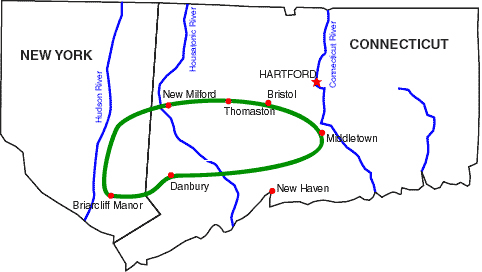
The green trail shows the Leatherman's 365-mile
route.
A true outdoorsman, The Leatherman didn't survive on handouts
alone. Through his experience he knew how to deal with everything
mother nature threw at him. Though he would be invited to sleep
indoors or in barns by good Samaritans, he always chose to sleep
outside or in one of his many caves.
Bourglay tended to the finest details before leaving each day's
sleeping location. He would gather wood for his next fire and safely
store it in the cave, so when he returned he could quickly get a fire
started with timber that had been stored under the cover of rock for
34 days. His fires would quickly warm the small cave by heating the
rocks around him to a comfortably warm temperature, even on the
coldest winter nights. His bed was made of the rocks by his fire, and
of course his thick leather suit added some additional padding.
For almost three decades, Jules Bourglay made his journey through
heat, rain, drought, and bitter New England winters. The Leatherman's
routine would suffer only one setback. The harsh blizzard of 1888
slowed his cycle by four days. Bourglay, now in his mid-60s, would
never recover from the hardship. The weather, combined with his age
and hard life, made him ill. He made it through the rest of the winter
but finally expired in a cave on the George Dell farm in Briarcliff
Manor, New York.
The Leatherman's Caves Today
Today the Leatherman's caves still stand. One of the most famous is
located on the Mattatuck Trail in a section of state forest in
Watertown, Connecticut. A good starting point to reach the cave is the
Black Rock State Park on Watertown Road in Thomaston, Connecticut.
Leatherman Cave is approximately a two-mile hike into the woods from
the state park. It is a blue-blazed trail and well-marked, but it is
rocky and at times very steep. A trail map may be available from one
of the park rangers on duty.
Making the hike in the summer wearing good hiking boots, shorts,
t-shirt, and a backpack with water and fruit in it makes one truly
appreciate what the climb must have been like in winter wearing sixty
pounds of leather.
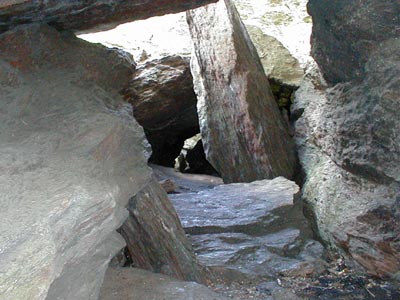
Leatherman Cave in Thomaston, Connecticut
The cave itself is actually several enormous rocks stacked together
like a card house. One entrance is a tight fit, requiring you to crawl
through an opening, where the other side of the cave is completely
open. If Jules Bourglay were still making his journey today, he would
be most disturbed that his caves have become attractions on popular
hiking trails.
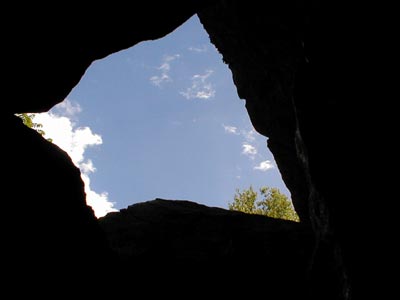
The view looking up from the center of Leatherman
Cave. The rocks form a natural chimney for campfires.
In the summer, Leatherman Cave is a cool place, completely in the
shade, and lying in the shadow of a mountain. In the center of the
dark cave, everything is very quiet and still. Many animals have no
doubt taken refuge in Bourglay's cave. Hundreds of hikers have passed
through enjoying the nature setting, but none of those visitors could
possibly understand the mindset of the Leatherman.
Bourglay didn't wander someplace new every day, never stopping at the
same place twice, and he never put roots down in any one location. He
methodically trekked in the same circle for years.
With almost thirty years of perpetual, methodic motion, could his lost
love for Miss Margaret Laron keep him forever moving to forget his
past? Could he still be making that same 365-mile journey today?
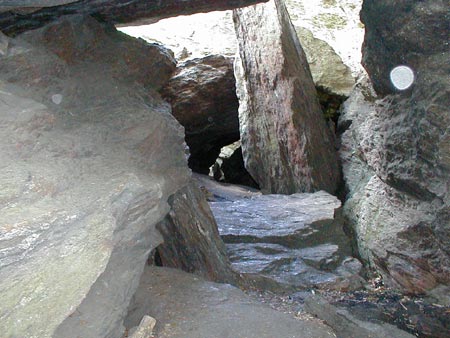
The last picture taken before leaving Leatherman Cave.